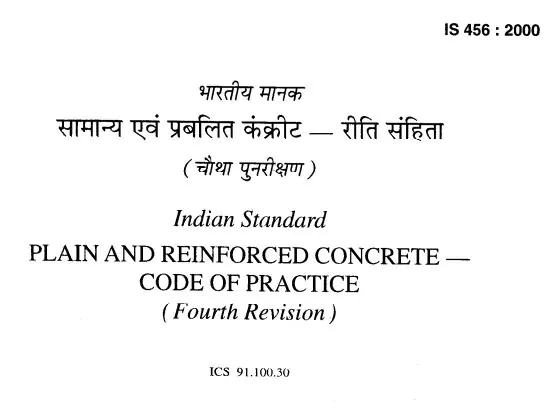‘Indian Standard 456: Plain And Reinforced Concrete’ PDF Quick download link is given at the bottom of this article. You can see the PDF demo, size of the PDF, page numbers, and direct download Free PDF of ‘IS 456:2000 Plain And Reinforced Concrete Code’ using the download button.
Is 456 Code And Important Points PDF Free Download

Cement
The cement used shall be any of the following and the type selected should be appropriate for the intended use: 33 Grade ordinary Portland cement conforming to IS 269.
- 43 Grade ordinary Portland cement conforming to IS 8 112.
- 53 Grade ordinary Portland cement conforming to IS 12269.
- Rapid hardening Portland cement conforming to IS 8~041.
- Portland slag cement conforming to IS 455.
- Portland pozzolana cement (fly ash based) conforming to IS 1489 (Part 1).
- Portland pozzolana cement (calcined clay-based) conforming to IS 1489 (Part 2).
5.1.1 Low-heat Portland cement conforming to IS 12600 shall be used with adequate precautions with regard to removal of formwork, etc.
5.1.2 High alumina cement conforming to IS 6452 or super sulfated cement conforming to IS 6909 may be used only under special circumstances with the prior approval of the engineer-in-charge.
Specialist literature may be consulted for guidance regarding the use of these types of cement.
5.1.3 The attention of the engineers-in-charge and users of cement is drawn to the fact that the quality of various types of cement mentioned in 5.1 is to be determined on the basis of its conformity to the performance characteristics given in the respective Indian Standard Specification for that cement.
Any trademark or any trade name indicating any special features not covered in the standard or any qualification or other special performance characteristics sometimes claimed/ indicated on the bags or containers or in advertisements alongside the ‘Statutory Quality Marking’ or otherwise.
Size of Aggregate
The nominal maximum size of coarse aggregate should be as large as possible within the limits specified but in no case greater than one-fourth of the minimum thickness of the member, provided that the concrete can be placed without difficulty so as to surround all reinforcement thoroughly and fill the comers of the form.
For most work, 20 mm aggregate is suitable. Where there is no restriction to the flow of concrete
into sections, 40 mm or larger size may be permitted.
In concrete elements with thin sections, closely spaced reinforcement, or small cover, consideration should be given to the use of a 10 mm nominal maximum size.
Plums above 160 mm and up to any reasonable size may be used in plain concrete work up to a maximum limit of 20 percent by volume of concrete when specifically permitted by the engineer-in-charge.
The plums shall be distributed evenly and shall be no closer than 150 mm from the surface.
For heavily reinforced concrete members as in the case of ribs of main beams, the nominal maximum size of the aggregate should usually be restricted to 5 mm less than the minimum clear distance between the main bars or 5 mm less than the minimum cover to the reinforcement whichever is smaller.
Coarse and fine aggregate shall be batched separately. All-in-aggregate may be used only where specifically permitted by the engineer-in-charge.
in case of doubt regarding the development of strength, the suitability of water for making concrete shall be ascertained by the compressive strength and initial setting time tests specified in 5.4.1.2 and 5.4.1.3.
The sample of water taken for testing shall represent the water proposed to be used for concrete, due account being paid to seasonal variation.
The sample shall not receive any treatment before testing other than that envisaged in the regular supply of water proposed for use in concrete.
The sample shall be stored in a clean container previously rinsed out with similar water.
The average 28-day compressive strength of at least three 150 mm concrete cubes prepared with water proposed to be used shall not be less than 90 percent of the average strength of three similar concrete cubes prepared with distilled water.
The cubes shall be prepared, cured, and tested in accordance with the. requirements of IS 5 16.
The initial setting time of the test block made with the appropriate cement and the water proposed to be used shall not be less than 30 min and shall not differ by& 30min from the initial setting time of the control test block prepared with the same cement and distilled water.
The test blocks shall be prepared and tested in accordance with the requirements of S 403 1 (Part 5).
5.4.2 The pH value of water shall be not less than 6.
5.4.3 Sea Water
Mixing or curing concrete with seawater is not recommended because of the presence of harmful salts in seawater.
Under unavoidable circumstances, seawater may be used for mixing or curing in plain concrete with no embedded steel after having given due consideration to possible disadvantages and precautions including the use of an appropriate cement system.
| Author | – |
| Language | English |
| No. of Pages | 107 |
| PDF Size | 15 MB |
| Category | Education |
| Source/Credits | elibrarywcl.files |
Is 456: Plain And Reinforced Concrete PDF Free Download
